Evolving 'Polly Wee'
|
|
Chris,
Is the spray dodger permanent? I can't tell from the photos. I'm tempted to ask where the steering wheel goes. -Paul |
|
|
I can't wait to see what the boat tailed car is going to look like.
|
|
|
In reply to this post by Paul H (admin)
Yes Paulie
This lower forward section is in fixed 4 mm birch ply: 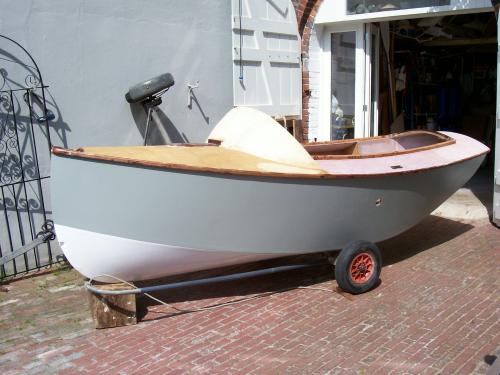 but the idea is to have a collapsible canvas upper aft section reaching almost up to the boom and perhaps another 18 inches back. The theory behind this is that I need to be able to get far enough forward to lift the mast out while standing within the cockpit and also to reduce windage when possible, but to still provide a way of dodging some stuff and you can actually even remain upright when underneath this piece if you sit on the cockpit sole. Now watch me put it all into practice? CW |
|
|
This post was updated on .
Chris,
Personally I think the fixed dodger and decks are the quintessential design feature of Premise 12 She is the perfect compromise between an open dinghy and a cabin cruiser - it is easy to extend the dodger a wee bit whilst sailing through the lumpy stuff ....then extend it further as a boom tent for sleeping. Did you consider polycarbonate for the dodger? Expensive but better visibility. Add my electrowizardry and a steering wheel and the result is a very graceful river motor boat with classic lines.....silent but rowable and yuloh-able. -Paul |
|
|
So that’s just about June then
And a grimbling little month it has been, hasn’t it possums? From the sodden snaps of the Lechraid and Beale, you can see that ‘Polly Wee’ did actually make it. As the clock struck midday on the Sunday we were meeting at the head of the river, (a sort of counter insurgency to the Jubilee gathering downstream), I crawled out from under the trailer having lashed her down through her empty centreboard case and off we went. I still haven’t made the centreboard yet and it seemed the best way of securing her, in consideration of the freshly grey decks, whose paint would definitely not have tolerated tight and jiggling cordage for the road trip to Lechlade: 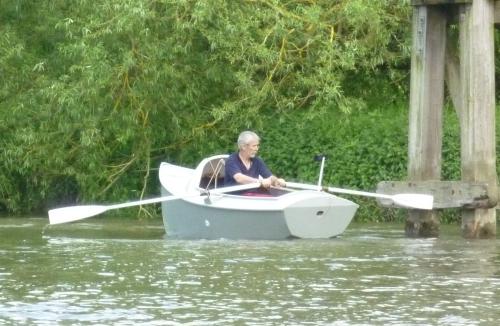 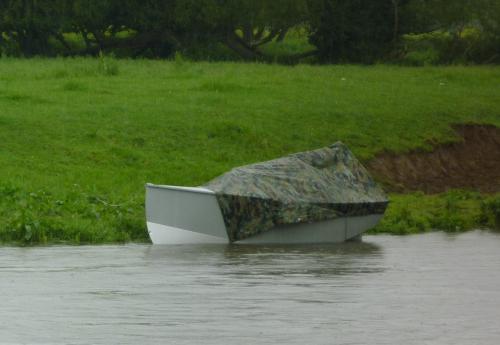 How did she behave? Well I have hopes. The water-ballast system was in and even dry (joke?), she is quite tolerably stable and stiffened up enough, with both ‘tanks’ full, to allow me to tuck my toes under the thwart and hike well out, without heeling much more than twenty degrees or so. Filling the port ‘tank’ only allows for sleeping in the net berth to starboard, with the boat upright. She seems to go quite well under oar, with a noticeable difference having the tanks flooded. I tried it, I think the day we came through Oxford and after an hour or so I began to worry that all that would be found of me was a torso in the boat and bobbing down the river a couple of arms, with the hands still clutching a pair of white oars: http://www.youtube.com/watch?v=0nN2oNHBJLM&feature=youtu.be So, a sort of Cinderella who made it to the ball with some considerable difficulty. Without benefit of pumpkin and a lot more angular, still in her underwear and no glass slipper, which quite rightly went to TimmO’s ‘Zelva’ for being very beautiful And finished Formidable fragrance, that Varnol. I have learnt that it’s no good putting a boat in for a competition when there is more of it still in your head than there is on the hull CW Oh and by the way, when you install a water-ballast system, it is as well to tighten the hose-clip where it connects to the seacock, otherwise you’ll spend the week blaming the weather for the somewhat excessive bilge water. |
|
|
But I am getting ahead of myself
On the vague plans that I drew up for her, the vaguest bit is a faint smudge leading generally up and backwards from the after edge of the foredeck – something maybe one day more substantial than a simple coaming then. There definitely wasn’t room for a full cuddy as I wanted to be able to reach and install, or extract, the mast while standing in the cockpit. The other thing is the requirement not to ‘rabbit chop’ yourself when coming to the end of each long, strong stroke of the oars. Rabbit chop? Hold bunny up by the hind legs and deliver a swift blow to the back of the neck with the edge of your other hand; the idea being to despatch it rapidly by breaking the cervical spine. Not that I was being held by the legs, but I did not fancy decapitation by guillotining myself with the aft edge of a cuddy. So a sort of Cud-ulette Originally, I was wondering if it would be possible to rotate the side decks up and round to form the cuddy sides as they ran forward, but certainly on the Premise 12, there just isn’t the length; maybe on the 16. In fact there is only room to install a moderate and rather upright sort of cowl; let’s call it ‘pert’. However it does give a substantial dry space leading under the foredeck for kit and even parts of the crew. The theory so far goes that this will form a solid base section and sometime I may add a canvas extension, reaching right up under the boom, for inclement weather; well is there any other sort? How did I get the shape? Putting a pencil mark above the boat where the boom is due to set (same principle as sky hooks), then a load of con-stickery and cardboard cut-outs and general fuffing around. Start imagining where the top edge of the frame will come and stick-build toward it:  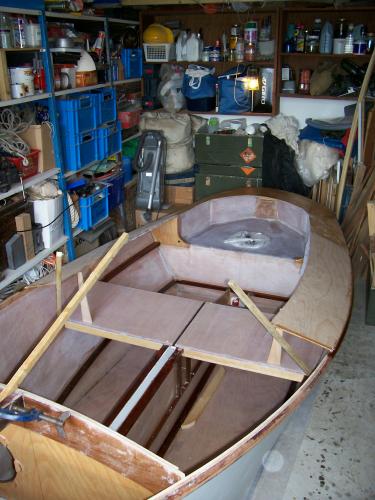 Develop the frame:   Wrong (lumpy), but note that by the time I had got it right, I had also decided on a small central ledge for the cleats for the sail handling lines; at one point I propped up a board to make sure it was all in the same plane. I was pleased to get the frame for the after edge to originate from the leading edge of the thwart in a single bold swoop and it left somewhere to incorporate a couple of small buoyancy tanks, which also act as support under the side decks, where the crew is most likely to have to sit her out: 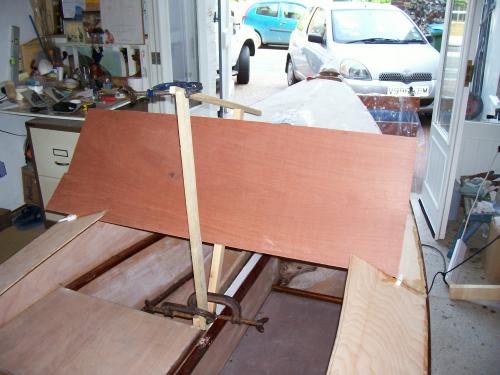  Finally with the frame in the three covering pieces of the 'cudulette' could be mocked up and installed:     And finally:  The outer edges of the cuddy were a compromise between something too narrow to be any use and the full beam for protection; it leaves enough room to run the oars forward along the side decks. The other thing was to try and give the impression of a compound curve to the structure without actually having to build any compound curves - doing fiddly things with the seams between the three parts seemed the best compromise. Actually the whole thing is a compromise and next time Back in the bilges CW |
|
|
Yes, back in the bilges
After the thrills of the Thames and Beale, reality struck - the inside of the boat needed painting out and that meant some attempt to flatten the bigger lumps and dribbles first:  Then on Saturday I set to with the white Jotun Hardtop HB and spent an intoxicatingly liverish day scuffling around under the foredeck, imagining the underside of the mast step thingies and stringers. Then using a mirror to find out where I had missed - the usual series of streaks, gaps and splotches; finally craning my neck to see under the stern deck. Pity you can't turn it inside out like a sock really. Despite my highest hopes, a litre won't do of course and I was left with about 250 ml and at least one more coat required. I tell myself it's something to do with the granular, non-slip texture. However this produces a problem of its own; the morrow was Sunday, so no ordering paint until today Monday and it won't arrive until tomorrow (Tuesday) - if I'm lucky. So the first coat will have almost had time to go hard enough not to properly make chums with the two-pot gloop that is even now winging its way toward Arundel and I'll be stuffed if I'm going to try and sand it all down yet again. I'm also going to run out of slowly-soluble mini-sponge rollers, before she's truly all white inside. What to do? Well at least get a second coat on some of those impossible little places and where the masking tape is defining a few edges, before that also sees the chance to cause trouble. At about four this morning, my bladder decided it wasn't sleepy any more, so I got up and headed for the garage. First off the rubber plunger in the paint-measuring syringe, (it's the only one I have available at present), had managed to absorb enough paint juice to go soft and sticky and I spent a happy few minutes fishing it out of the barrel of the syringe and helping it find out what the solvent could really do. Then I tried to get the lid off the jam jar with the paint brush, standing-in solvent in it and despite going into the kitchen and fetching the jar opener, it was stuck fast. Give up; how about a new jar? There's a box in the back of the garage full of empty containers, but glass jars are getting thin on the ground, so I started pulling out all the plastic tubs and things and as I did so, my elbow caught the spidery, hosey ballast system hanging near by and that saw a large jar with the substantial remnants of some sloppy concrete sealer and tapped it gently off the shelf. Smashing So then I had a syrupy, splintery, glass-impregnated mess half underneath the port bow and I was still no nearer starting the second coat. It took an hour of stuffing around to get that far. And now it's done, and it looks as if I've been in there with something more like a plough than a paint brush. Heavens above CW |
|
|
'Heavens above" sounds unreasonably restrained.
If it were I (and the circumstances sound like ones I am oft able to recreate in my own way) the language would be stronger and I would feel the need to find some innocent object to hit repeatedly with the nearest available implement of destruction in order to safely vent the full extent of my feelings! Sorry, long sentence. My dear wife, when she is aware of these moments, does remark that building a boat is supposed to be a relaxing and therapeutic process. You will understand the precise extent to which such remarks are helpful. Tim. -- So then I had a syrupy, splintery, glass-impregnated mess half underneath the port bow and I was still no nearer starting the second coat. It took an hour of stuffing around to get that far. And now it's done, and it looks as if I've been in there with something more like a plough than a paint brush. |
|
|
In reply to this post by Chris Waite
Happy days…………………………Tony From: Chris Waite [via UK HBBR Forum] [mailto:[hidden email]] Yes, back in the bilges |
|
|
Remember how I told you the interior would be all white in the end?
Well, thanks to Jotun and their endless supply of high-octane, two-part poly here it is and my liver is really, really glad we’re back on the Sauvignon:  Next question, what would this pass for a rough model of the Scottish Parliament building?  Keep paying attention, then maybe you’ll find out what it really is. In the mean time I have started on the centreboard and rudder; we’ll also get to the latter later, but I allowed an inch for the thickness of the centreboard as I only want to be doing this once (please) and I have previously had three quarter inch ply demonstrate a discouraging tendency to give up under pressure. To make up my nearly-an-inch, I decided to laminate up a couple of pieces of cheap 9mm. WBP with the remnants of the 3.5 mm, birch, decking ply sandwiched between them. This may sound like a strange choice, but the 9 mm WBP board that I have used for some of her important little places are five ply (so is the 6mm I have used for the hull actually). That is they have a papyric layer of something reasonable running the length of the board and immediately under this is a substantial layer of the usual junk, running sideways across the board sandwiching a slim central lengthways sliver. I assume this is to reduce the requirement for eight foot runs of the grain. This means that if you cut your centreboard across the ply sheet and make it up of two pieces with genuine lengthways birch in the middle, you end up with four humpty-junky and two beautiful birch laminates all running the length of the board:   All this is on a one inch thickness and even after forming a suitable foil section. But going on to reach for the trusty Tesco’s poly-cotton sheathing sheets, it should be reasonably robust. Oh, please And here is the blank, being given a first fitting: 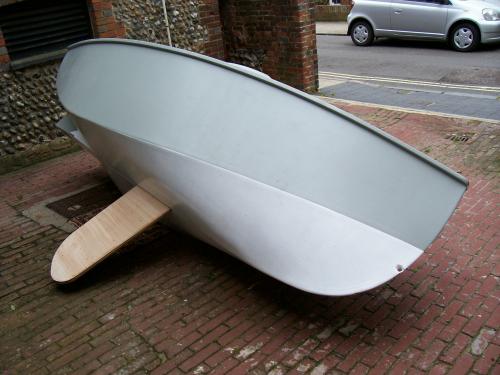 Interesting that she will roll over and lie on her side; it’s all in the training, of course:   Can yours do that? Now this is all getting a bit bitty…. And it’s due to get worse as I work all the remaining aspects toward the final product, so bear with me. And that funny structure – you’ll have to wait until next time “Final product” Mmmmmm! CW |
|
|
Chris,
What thickness for MilliBee's centreboard? Her rudder is two lots of 9mm laminated, cross grained I think, and it feels rock solid.....I plan to do the same for the centreboard. She also rolls obediently and settles on her chines. -Paul |
|
|
Paulie
Dinghies of our sort of size tend, tend to have 3/4" (18mm) centre/dagger boards, though I think the Mirror may only be 1/2" and the rudder blades mostly the same 1/2", not normally much less (?3/8"). The only spectacular failure I have had is the 3/4" board on 'Rosie Mae' when the current in the Arun took us over some rough spoil with two big blokes on board. On the other hand, 'Tit Willow' has a foil section centreplate made up of a 6mm stainless plate with shaped ply cheeks, perhaps some two and a half inches in total: 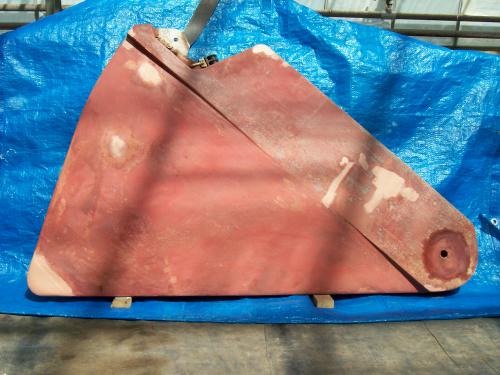 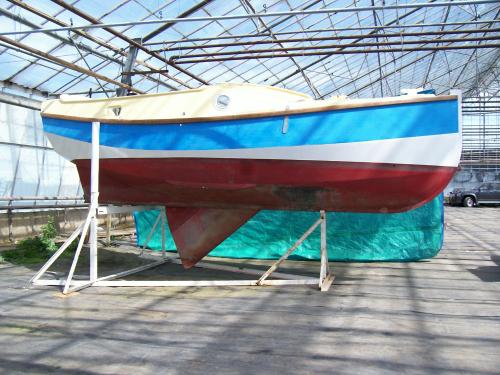 'Millibee' is somewhere in between and I think what you need to consider is when her displacement bounces the centreboard of something grumpy and unforgiving and you run out of other options if it breaks. Bear in mind you already set her up with steel plate in the bilge boards you had. If it was my pocket cruiser, I wouldn't go less than an inch and probably more like and inch and a half, though Ruthie will tell you I have a penchant for overbuilding.... Your move next CeeDub |
|
|
“What’s in a name? A rose by any other name would smell as swee
The ‘Wee’ is as in diminutive and if there are any more pottyform wise cracks, then I shall have to start referring to her as ‘Pee Dubs’ Pee? Well, I give up then, but here is how her tush turned white: 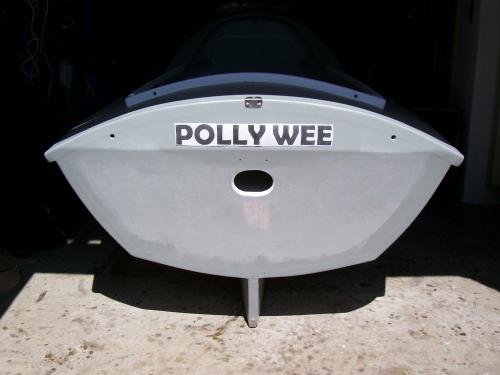  Not special and because the lower section of the transom is raked, it is important to at least start the name on the top section, if it is to be easily visible:   Better; and the final result:  Cee Dubs |
|
|
Nice! On 27 Jul 2012, at 20:32, Chris Waite [via UK HBBR Forum] wrote: “What’s in a name? A rose by any other name would smell as swee |
|
|
In reply to this post by Chris Waite
From: Chris Waite [via UK HBBR Forum] [mailto:[hidden email]] “What’s in a name? A rose by any other name would smell as swee If you reply to this email, your message will be added to the discussion below: http://uk-hbbr-forum.967333.n3.nabble.com/Evolving-Polly-Wee-tp3339755p4025460.html To unsubscribe from UK HBBR Forum, click here. |
|
|
Time to put the water ballast system to bed. If you go back to my entry of 20th July, you can see the bilges painted out and looking closely I have put in some ‘floors’. Isn’t that the right term for partitions in the bilges? These ones retain the water ballast bags, stopping them sliding fore and aft, having satisfied myself that they were in the right position during the Thames trip. If the system will take it, this is going to be mostly a series of pictures.
Firstly I did decide to put a two-way valve in, under the pump, so that I can separately pump out the bilges or the tanks. The hose leads forward along the port side of the case and rather than a strum box I drilled a series of small holes in the underside of the hose, plugged its end with…. a plug. I looked around the garage for ever to find something suitable and got to that ridiculous point where I went on searching even after finding something as perfect as a one and a half inch bath plug. Eventually I relaxed and allowed myself to set it up with a hose clip (not shown) and a stainless tab bolted through it and extending sideways to be screwed down, holding the end flat in the bilges:   The second picture shows the whole plumbing system without the bags in place, note the pump drains through a hose (going under the thwart) leading to a skin fitting in the port side of the hull. Then the next two show details of each section:   You may reasonably feel that it all looks rather messy, but without resorting to custom made parts, it was necessary to combine readily available chandlery to create the system. In fact the Plastimo flexible water tanks are both 150 litres and there is only enough room for each to be half full, so they go in folded and the volume is limited by the space available under the screwed down floorboards:   And, oh look! There’s that model Scottish Parliament Building; a guard to discourage the valve handle and the port tank taking an unnecessary interest in each other. Finally; Au revoir tanks! May you lurk, heavily in peace for ever; there is a hole in the floorboard below the forward edge of the thwart, to reach the ballast/bilge valve:   But wait; there is one other thing: 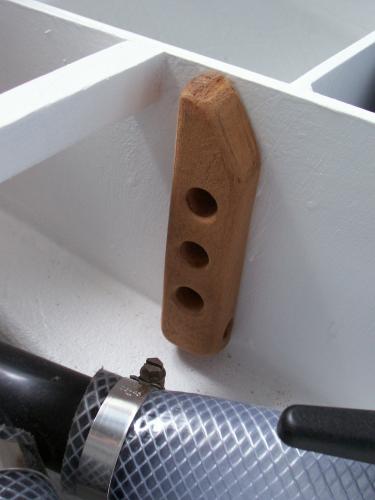 What on Earth is this? CW |
|
|
Hi all,
Grum here, just back from Cobnor, where I've been playing Swallows and Amazons with my chums, and what a jolly time was had by all. A fuller report will appear elsewhere. Cee Dubbs brought Polly Wee and got her rigged for her Maiden Voyage under sail. He sneaked out of the camp site at 6.30 am whilst most still snored on and, almost as if he had planned it all along, managed to combine her first sail with a circuit of Hayling Island and so completed the Hayling Challenge. You just can't keep a good man down. Later in the week he decided to do a capsize test so we all sailed over to East Head where there is a nice sandy bottom. So here is the evidence of how she behaved with the ballast tanks filled. Enjoy. Polly Wee Takes a Bath |
|
|
And on the Sunday he slipped out at seven o'clock and did a figure-of-eight circuit round Hayling and Portsea Islands. That is just showing off.....
|
|
|
Actually I am agog at this. The timing was spot-on, getting the tide inbound for the Portsmouth Harbour leg so he got nicely under the bridges of Port Creek, which are all far too close to the water for comfort at high tide and where the water is far too skinny for comfort at most other times.
We were getting a bit concerned when he still hadn't got back at tea time, but he swanned up with the tide (again) with a great big smile all over this face at exactly beer o'clock. |
|
|
I had the great honour of being the first crew member on Polly Wee. Chris concluded my (slim-ish) 70kg contribution to ballast improved her handling a lot - the ballast tanks are half full (or is it half empty?) at about 150kg so by raising the floor boards the tanks can expand to take on more water.
The small cuddy gives good protection from wind and spray and I think she will be very seaworthy. She heals a tad too much (more than me in Tigger) but I blame that on the Arundel council for making the bollards too close. Personally I would go for the full 300kg of water ballast but Chris will experiment with bags of gravel. -Paul |
| Free forum by Nabble | Edit this page |

